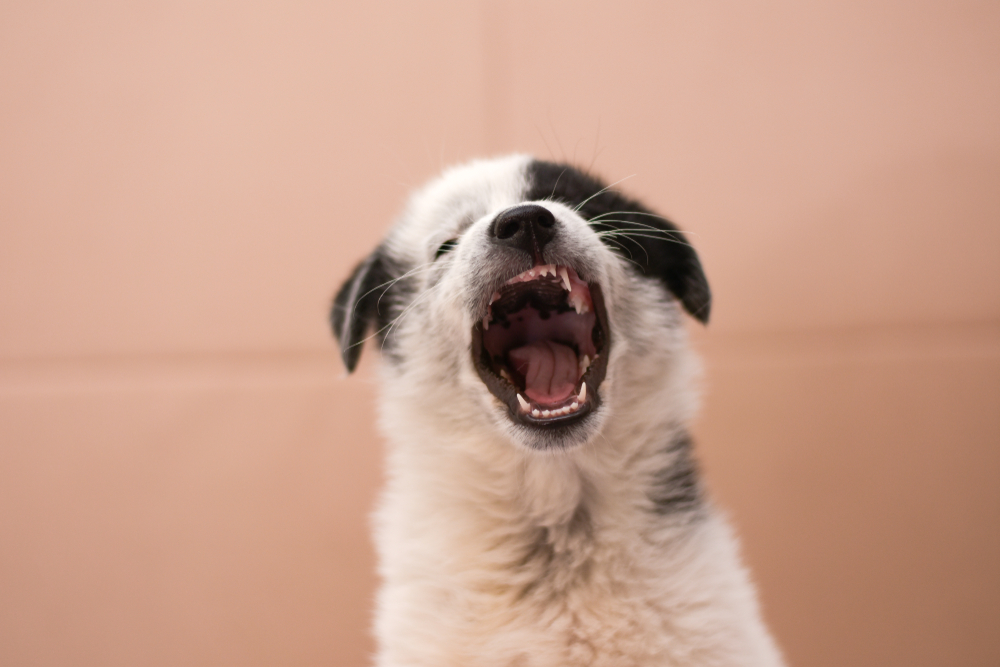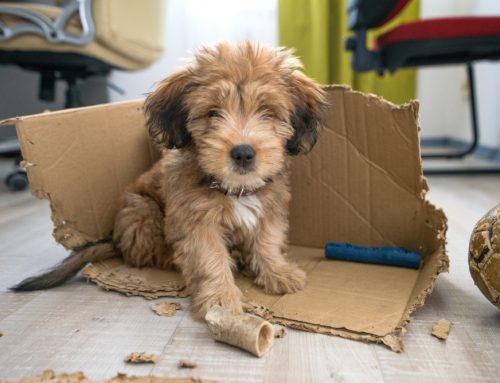Ah, puppy teeth! Nothing quite ruins an idyllic moment with a snuggly puppy like the sting of four tiny needles in your arm. Fortunately for them, puppies are cute, and we’re happy to forgive these minor, painful indiscretions. Although you may have difficulty imagining a time when your puppy’s sharp teeth will be replaced by mature, less dagger-like dentition, now is the time to create a foundation for your puppy’s lifelong dental health.
Why puppy dental care matters
Why start so early, you may ask? Unfortunately, by age 3, 80 percent of dogs show periodontal disease signs. Periodontal disease is a painful, but preventable, condition caused by plaque and tartar accumulation below the gumline, resulting in gingivitis, tooth decay, infection, and bone loss.
Improve your puppy’s dental health in four steps
Positive early experiences with handling and toothbrushing can establish a routine of daily dental care. Home care, plus annual dental screenings at WesVet Animal Hospital, can effectively fight against periodontal disease. Start your puppy off on the right paw with these four steps:
#1: Have your puppy’s teeth examined at WesVet Animal Hospital — If your puppy hasn’t made their veterinary debut yet, it’s time to schedule a puppy exam. During the exam, the veterinarian will assess or look for:
- Present teeth — Puppies begin to lose their teeth at 16 weeks old, and have all adult teeth by 6 to 7 months of age.
- Erupting teeth — Your puppy’s 28 deciduous teeth are replaced with 42 adult teeth.
- Proper occlusion—Malocclusion (i.e., the misalignment of the teeth and bite) can affect your dog’s chewing ability, and dental health.
- Retained teeth — Retained puppy teeth can crowd incoming adult teeth, and cause incorrect development. Retained teeth are easily removed during your puppy’s spay or neuter.
#2: Make dental exams a game for your puppy — When you have a puppy, you spend a lot of time removing inappropriate items from their mouth—shoes, paper, your hand—so, not wanting us to look at their teeth is no surprise! Teach your puppy to cooperate with the dental exam—and any other reason you need to check their mouth—by pairing the exam with an exciting treat, such as dog toothpaste.
For this training, apply the toothpaste directly to your finger, following these steps:
- Lift that lip — With your puppy happily licking the toothpaste, reach over the muzzle, and gently slide the upper lips away, to expose the teeth.
- Touch the teeth —Next, slide your toothpaste-finger along the gums and tooth surface on all three sides in a brief, gentle action.
- Open wide — After several sessions, apply gentle pressure behind your puppy’s canine teeth, and gently open their mouth for a moment. Release and reward with play or treats.
Ensure you select an enzymatic toothpaste approved by the Veterinary Oral Health Council (VOHC), and use only toothpaste labeled for dogs—human toothpaste is harmful to dogs when swallowed.
#3: Start brushing your puppy’s teeth — Once your puppy is comfortable having their mouth handled, you can introduce toothbrushing. Start with a finger brush or a soft child’s toothbrush, which are easiest to maneuver in those small mouths.
If you’ve spent time building value for the dental exam, this should be an easy transition—you’re simply replacing your finger with a brush:
- Introduce the brush — Let your puppy investigate the brush while you hold it. Add a little dog toothpaste, and let them lick off the paste.
- Review what they know — Set the brush aside, and practice touching the teeth with your finger as before. Reward your pup.
- Ready, set, brush — Load the toothbrush with paste, and make gentle contact. Start with the side teeth, which are easiest to access. Focus on each tooth’s outside surface, where most plaque and tartar accumulate.
- Take breaks — Toothbrush contact needs to be only a few seconds per area, initially. Take a mini break in between each repetition, to help your puppy stay focused and comfortable. Practice daily.
Remember, brushing your puppy’s teeth is about building a behavioral foundation for life, rather than achieving an in-depth dental cleaning. Avoid frustration by keeping the entire process short—like your puppy’s attention span!
#4: Provide proper chew toys for your puppy — Chewing behavior can relieve stress, discomfort, and decrease unwanted behavior, but improper toys can fracture your dog’s teeth. WesVet Animal Hospital strongly discourages raw or cooked bones, hooves, antlers, or yak’s milk chews for puppies, or adult dogs. Puppies younger than 6 months can be given the following safe options:

- Plastic or rubber teething toys — Kongs or Nylabones, for example
- Edible puppy teething rings — Ensure the product is labeled for puppies under 6 months.
- Raw or frozen vegetables or fruit — Try green beans, carrots, watermelon, or cantaloupe.
Always supervise your puppy when playing with toys or chews, to prevent choking or ingestion of non-food items.
When taught in a positive manner right from the start, dental care will become a natural and enjoyable part of your puppy’s daily routine, and a strong defense against periodontal disease. Once your puppy grows up, annual exams at WesVet Animal Hospital will ensure that your home-care regimen is effective, and detect any early changes in your dog’s oral health.
For additional information about dental care in puppies, or to schedule your puppy’s appointment, contact the team at WesVet Animal Hospital.







Leave A Comment